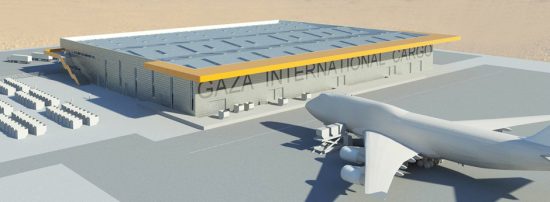The Project Unified Assistance (PUA) seeks to rehash the idea of a humanitarian airport supervised by the UN, in the fifties and sixties of last century, east of Gaza city.
Five years ago, Ahmad Al-Khatib, the projects’ director, launched an initiative to establish a UN airport in Gaza, in an attempt the ease the livelihoods of Gazans living under blockade since ten years.
(PUA) is a US-based humanitarian nonprofit organization advocating the establishment of a UN operated and regulated airport in the Gaza Strip, according to Al Ray Palestinian Media Agency.
Al-Khatib assured that the idea is not extraordinary, adding that the United Nations operated, between 1956 and 1967, an airport in the Gaza Strip as a part of the United Nations Emergency Force, which was created in order to supervise the “disentanglement” of the armies of Egypt, Britain, France and Israel, in the Sinai Peninsula and the Gaza Strip.
Historical images show UN planes at the Gaza Airport, which served the UN Emergency Force and Gaza’s inhabitants. The use of the airport was expanded from military purposes to civilian applications whereby UN planes provided transportation services and carried passengers and humanitarian/commercial cargo to and from the Gaza Strip, Al-Khatib added.
Al-Khatib said that the UN airport may represent a window of hope of patients and students stuck in Gaza, and contributing to the reconstruction process.
See archive IMEMC video: Gaza City’s Devastated Al-Shuja’eyya Suburb
A recent United Nations report warned that the Gaza Strip will be uninhabitable by 2020 for its 1.8 million residents.
According to the report, serious changes must be implemented to reverse the damage done to the coastal enclave’s development. Additionally, the World Bank warned, in May of 2016, that Gaza’s economy is on the verge of collapse and that youth unemployment is the highest in the region, at 60%. After years of war, destruction, and poverty, an airport for functional purposes could help accelerate Gaza’s reconstruction and redevelopment process. It would also relieve Gazans’ chronic inability to travel in and out of the Strip in an effective and safe manner, Al-Khatib highlighted.
Al-Khatib demonstrated the social, economic and political benefits of creating an independent travel mechanism that would allow Gazans to exit and enter the territory through a secure non-Egyptian and non-Israeli crossing.
The idea will develop a sound operations model and effective procedures for how the airport is to be operated by the United Nations with financial support from Arab, regional, and international stakeholders, he added.
PUA identified a new site that will allow airplanes to fly over Mediterranean and international waters, in order to avoid Israeli airspace. After detailed analysis, PUA proposes the construction of an airport on the southwestern coast of the Gaza Strip between the cities of Khan Younis and Rafah, on the grounds of the former Jewish settlement of “Gush Katif”, in an area known as “al-Mawasi, according to Al-Khatib.
Project Unified Assistance said that this airport to be used by all Palestinians wishing to travel to and from the Gaza Strip. Additionally, and per the UN’s aviation model in other parts of the world, the airport will be available for use by UN staff and workers with various NGOs who are contributing to the humanitarian relief and reconstruction efforts.
At this time, the humanitarian situation in the Gaza Strip is critical.
There are ongoing border closures, the reconstruction process has barely begun, tens of thousands remain displaced as a result of the 2014 war, patients with a variety of illnesses are unable to receive or travel for proper treatment, and the healthcare sector is suffering from chronic shortages and challenges. Hence, PUA’s proposal to establish an airport operated and regulated by the UN will not end the blockade of Gaza, nor will it solve the Strip’s problems, Al-Khatib concluded.
Edited by Chris Carlson, imemc.org

